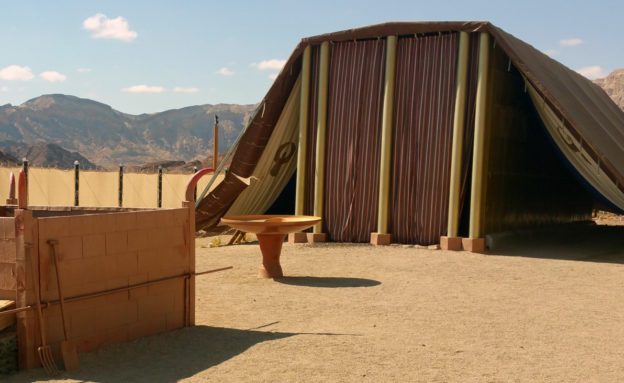Buckingham Palace. The White House. Both of these buildings have something in common; they are a place for the leader of their nation to live in. Given their symbolic place and their occupant, these places are well kept, well protected, and well appointed.
If this is true of a place for the Queen, then it is even more so true for God. If God was going to dwell with his people, he needed a residence “fit for a king”. And so in Exodus 26, instructions are given about the construction of God’s House, the Tabernacle. Yet these instructions are valuable beyond the architectural information for what it teaches us about the relationship of God with his people, and especially now that Jesus has come.
The Tabernacle was a tent, in keeping with the Israelites own tents in the wilderness, made with ten sheets of fabric about 2 metres by 13 metres (vv.1-2). They were made of linen dyed and decorated with cherubim, the angels that guard God’s throne. The ten sheets were sewed together into two sets of five sheets, which together formed the tent (v.3). Fifty golden loops and clasps allowed the two sets of sheets to be connected, forming a tent (vv.4-6).
The layer of linen was then covered with a layer of goat’s hair, and then two layers of animal skins to provide waterproofing (vv.7-14). It also covered the contents of the tent inside, making it difficult to “slip in” for a peek at God’s holy presence.
Like any tent, the fabric needed something to hold it up. This was through sturdy acacia wood poles, overlaid with gold and resting on silver pedestals, connected by golden crossbars and double columns (for extra strength) at the corners (vv.15-29).
This frame was what the fabric was draped over, then pegged down to provide a complete portable house for God. Moses was to ensure all these parts were made as described, and then erect the tabernacle “according to the plan for it that you were shown on the mountain” (v.30).
Within the tent were various contents to make things fit for a Great King. Firstly, a veil of similar colour and with Cherubim decorations was to be made, and hung on a frame made the same as the tent frame (vv.31-2). This created a separate, cube shaped room called the Most Holy Place within the tent, with the outer portion of the tent being the Holy Place (v.33).
Within the Most Holy Place, Moses was to place the Ark of the Covenant, above which God’s presence would dwell (v.34). In the Holy Place, the Table of the Presence and the Lampstand were placed (v.35).
Finally, Moses was to build a second screen of linen, as with the inner tent fabric and the veil into the Most Holy Place, to help screen the inside of the tent from view by the common worshiper (vv.36-7).
For the Israelites, this tent was the place in which God dwelled with them and by which they could access God in a special, covenantal way. That access was restricted, due to their sin, but real. That was why the tent had many layers, and the entrances to the tent and the Most Holy Place were screened.
All of Israel’s camp would revolve around God’s tent. They would approach it with sacrifices, which priests would offer on their behalf, entering the outer part of the tent. And once a year, the High Priest would enter the Most Holy inner room to offer sacrifices on their behalf.
The tent represented the cosmos, and God’s Plan for his presence to come down from Heaven to earth, and to ultimately spread through all Creation.
But this Plan could only happen through the sacrifice of the true dwelling-place of God with man, Jesus, who John the Apostle says dwelt (in Greek, literally, tabernacled; John 1:14) with us. Jesus’ death on the Cross ripped the veil limiting access to the Most Holy Place (Mark 15:38), because his death allows all people access into God’s presence.
Now that the veil is torn, we are able to more freely enjoy God’s presence. Through Jesus we “have confidence to enter the holy places by the blood of Jesus, by the new and living way that he opened for us through the curtain, that is, through his flesh” (Hebrews 10:19-20).
While the Israelites had access to God through the ministry of the priests, we have direct access by the blood of Jesus to God’s presence through the Holy Spirit dwelling within us. Not just when we first come to faith, or once a year, but every day.
Nor must our lives be perfect for us to come into God’s presence, because Jesus’ blood cleanses us of any unholiness which keeps us from God’s side. Instead, we can enter God’s presence through prayer and praise, confessing our sins and receiving God’s assurance of pardon and his continued presence with us. Not just today, but tomorrow, and on into eternity in the New Jerusalem.

